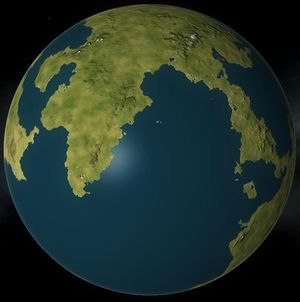Difference between revisions of "Kerbin"
| Line 1: | Line 1: | ||
| − | + | [[File:Kerbin.jpg|thumb|right|Kerbin as seen from orbit]] | |
[[File:NJ6qJ.jpg|thumb|right|A projection map of Kerbin]] | [[File:NJ6qJ.jpg|thumb|right|A projection map of Kerbin]] | ||
Revision as of 16:24, 14 June 2012
Kerbin is the planet where the Space Center is located and the main focus of Kerbal Space Program. It has two moons, named Mun and Minmus. It orbits the M class star Kerbol.
Contents
Characteristics
- Equatorial Radius: 600 km
- Mass: 5.29e22 kg
- Density: 58.467 g/cm^3
- Surface Gravity: 9.8068 m/s^2 or 1 g
- Gravitational parameter: 3530.461 km^3/s^2
- Escape velocity from surface: 3430.45 m/s
- Rotation Period: 6 hours; Rotation: 60 degrees per hour, or 174.5 m/s at the equator
- Kerbosynchronous Orbit altitude: 2868.4 km; Kerbostationary Orbit velocity: 1008.9 m/s
Orbital Characteristics
- Semi-Major Axis: 13,599,842,304m or 0.0909092522 Astronomical Units (A.U.)
- Velocity: 9284.5 m/s
- Orbital Period: 2,543 hours, or 106 Earth days
- Sphere of influence: ~ 84,275 km or 140 body radii
Topography
Kerbin has a roughly equal distribution of liquid water and solid land, with polar icecaps and scattered deserts. Between versions 0.7 and 0.14.1 (Including the current demo version of 0.13.3), some mountain ranges exceeded 600 m in height. The highest point was at approximately 900 m altitude.[1] In registered versions 0.14.2 and later, a new terrain engine has resulted in mountains exceeding 3200 m in height. The tallest mountain at least 3750 m.[[2]]
Atmosphere
Kerbin has an atmosphere of unknown composition. The atmosphere gets exponentially less dense as altitude increases (5 km scale height), and ends at 69,077.55 meters [3][4] It is possible that Kerbin's atmosphere consists of the same composition as Earth's atmosphere, but this is subject to debate. It will not be until life support is invented for Kerbals on EVA that we will truly understand what they need to survive. According to unofficial sources, they inhale ZO2.
Natural Satellites
As of 0.13.3, Kerbin had a single moon, The Mün. With 0.15, Kerbin has a second satellite, Minmus.
Reference Frames
| Paid (0.15.2) | Demo (0.13.3) | |
|---|---|---|
| Rotational/Inertial transition | 100,000 m | 70,000 m |
| Warp | Minimum Altitude | |
| 1x | n/a | |
| 2x | 0 m | |
| 5x | 69,078 m (above the atmosphere) | |
| 10x | 69,078 m (above the atmosphere) | |
| 50x | 120,000 m | 150,000 m |
| 100x | 240,000 m | 300,000 m |
| 1,000x | 480,000 m | 600,000 m |
| 10,000x | 600,000 m | 1,200,000 m |
